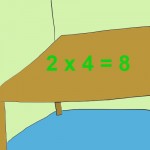
I remember that on my first day in a new school at age eight, there was a spelling test and a times table test. During the former, never really my strongest subject, I was kindly supported by the girl sat next to me who pointed at her answer for question five ‘wur’ after the teacher had asked for ‘were’. The latter, the times table test, consisted of random facts from all the tables, including up to 12×12.
Throughout this I had a tear in my eye as I realised that I knew nothing save 2×4 (I was 8 remember).
From that point on I was determined to learn and remember my times tables. But what options do we have for supporting the children in the learning of these facts. Well this is what this week’s waffle is all about. So mouths shut, number one to ten down the left hand side of your paper and we will begin!
As you can hopefully imagine, I always wanted to create a fun and enjoyable way of learning and assessing this area of mathematics and what I present here is a few methods that I have created or ‘magpied’ and used with various degrees of success.
- Teaching Times Tables – One thing that I was guilty of in the initial part of my career was that I assumed that the children some how knew their times tables. Week after week I would deliver the test without really thinking about who actually taught them these facts. So my first point would be to remember to actually teach the facts. This can be done in a variety of ways and some of the ideas are below, but always try to include the parents in the learning. In order to become fluent with the facts it is necessary to recall them in a range of different situations – I used to recommend that the parents asked random facts while walking home, travelling in the car or while shopping. This was only after the child had learnt the facts though, this was a way of encouraging the children to remember.
- Links to division – Division is one of the processes that children find difficult to learn. It is important that when teaching and assessing times table facts that we include the inverse of the fact. Instead of just saying 2 x 5 = 10 we should also be asking, and saying, and ten divided by five is two. Also, remember all the other facts that are within this calculation – 5 x 2 = 10 and ten divided by two is five. Teach all these together so the children acknowledge the connection between the facts and their inverse.
- Patterns are important – Whenever teaching mathematics I always think that supporting the children in recognising and using patterns is important. I consider that all the times tables facts are patterns in their own right, being sequences of numbers which follow a set pattern. When teaching I try and identify these patterns for the children and give them ways of remembering them. An example of these patterns would be that all two digits in the answers to the nine times table add up to nine 18, 27, 54 and answers in the five times table always end with either a five or a zero. Although these might be obvious to us and some children, it is important to relate these to the children.
when you come to assessing the children’s knowledge of their times tables, remember to vary your approach, use one method for a few weeks or even days and then change it. Here are some initial ideas, if you have any more then please let me know and I’ll feature your ideas or websites in next week’s comment show
Hope to enjoyed listening or reading Wilson Waffling. Remember keep up to date with my waffles by subscribing to;
Twitter
Blog
YouTube
Facebook
and now on iTunes!
Podcast
Have fun and catch you later!
